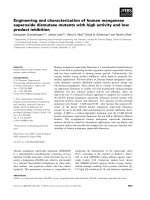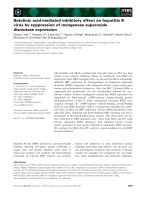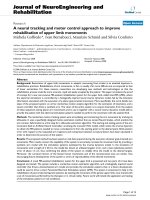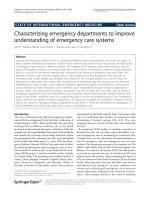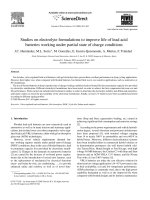Targeting mitochondrial manganese superoxide dismutase to improve treatment of breast carcinoma
Bạn đang xem bản rút gọn của tài liệu. Xem và tải ngay bản đầy đủ của tài liệu tại đây (27.7 MB, 271 trang )
TARGETING MITOCHONDRIAL MANGANESE
SUPEROXIDE DISMUTASE TO IMPROVE
TREATMENT OF BREAST CARCINOMA
LOO SER YUE
(BSc (Hons)), NUS
A THESIS SUBMITTED FOR THE DEGREE OF
DOCTOR OF PHILOSOPHY
DEPARTMENT OF BIOCHEMISTRY
NATIONAL UNIVERSITY OF SINGAPORE
2014
!
i!
DECLARATION
I hereby declare that the thesis is my original work and it has been
written by me in its entirety. I have duly acknowledged all the sources of
information which have been used in the thesis.
This thesis has also not been submitted for any degree in any
university previously.
_________________
Loo Ser Yue
20th November, 2013
!
ii!
ACKNOWLEDGEMENTS
I would like to extend my deepest thanks to the following people without
whom my PhD journey would not have been such a vibrant and enriching one.
First of all, I would like to thank my supervisor, Marie-Veronique Clement, who
is an outstanding researcher and advisor in many ways. She has taught me many
life lessons on endurance and perfection, which have been crucial especially to
my publication.
Next, I would like to thank my co-supervisor, Dr Alan Prem Kumar, who
has been the founding father and breadwinner of my project and as dear to me as a
parent nurturing a child. He has taught me skills ranging from bench-top to giving
presentations, constantly spurring me on to excel and giving me chances to learn.
I would not be the researcher I am today without him.
Also, I would like to extend my gratitude to Professor Shazib Pervaiz,
Professor Joo-In Park, Professor Jean Paul Thiery, Professor Peter Lobie,
and Dr
Gautam Sethi, for their generous collaborations with my project. I would also like
to thank my family and friends who have supported me during these four years.
Special thanks go out to Dr Eun Myoung Shin, Dr Diana Hay, Dr Chen Luxi, Ms
Goh Jen Nee, Mr Rohit Surana, Ms Shikha Singh, Ms Weiney, Ms Cai Wan Pei,
Ms Sakshi Sikka, and all members of the APK and MVC lab for their valuable
encouragement, friendship, and constant help throughout this memorable
experience.
!
iii!
TABLE OF CONTENTS
DECLARATION
ACKNOWLEDGEMENTS
TABLE OF CONTENTS
SUMMARY
LIST OF TABLES
LIST OF FIGURES
LIST OF ABBREVIATIONS
CHAPTER 1 INTRODUCTION
1.1 Breast Carcinoma
1.1.1 Trends of breast carcinoma in worldwide and Asia
1.1.2 Classifications of breast carcinoma
1.1.3 Treatment of HR-positive breast carcinoma
1.1.4 Treatment of HR-negative/ triple negative breast
carcinoma
1.2 Manganese Superoxide Dismutase
1.2.1 Dysregulated ROS levels in breast carcinoma
1.2.2 Structure and function of MnSOD
1.2.3 MnSOD in human cancers
PAGE
i
ii
iii
xiii
xv
xvi
xxi
1
1
1
2
6
8
11
11
12
14
!
iv!
1.2.4 Targeting MnSOD in breast cancer
1.3 Peroxisome Proliferator-Activator Receptor Gamma
1.3.1 Peroxisome Proliferator-Activated Receptors (PPARs)
1.3.2 Functional domains of PPARγ
1.3.3 PPARγ ligands
1.3.4 Effects of PPARγ activation in human cancers
1.3.5 PPARγ ligands in clinical trials
1.3.6 ROS production via PPARγ activation
1.3.7 PPARγ ligands in clinical trials
1.4 Effects of Histone Deacetylase on PPARγ signaling pathway
1.4.1 Histone acetylation and deacetylation
1.4.2 Histone deacetylase inhibitors (HDACi) in cancer
therapy
1.5 Involvement of Epithelial Mesenchymal Transition (EMT) in
Breast Carcinoma
1.5.1 EMT in cancer progression
1.5.2 Regulators and mediators of EMT
1.5.3 Targeting EMT in breast cancer
1.6 Project objectives and hypothesis
CHAPTER 2 MATERIALS AND METHODS
2.1 General buffer preparation
15
18
18
20
22
23
24
25
27
28
28
30
33
33
36
39
41
43
43
!
v!
2.2 Cell lines and culture conditions
2.3 Drug treatments on cell lines
2.3.1 Treatment of Cells with PPARγ ligands and antagonist
2.3.2 Treatment of cells with Docetaxel (DOC) and
Doxorubicin (DOX)
2.3.3 Treatment of cells with ROS scavengers
2.3.4 Treatment of cells with LBH589
2.4 Western Blot Analysis
2.5 RNA Isolation
2.6 Reverse Transcription and Real-time Polymerase Chain Reaction
2.7 Real-time Polymerase Chain Reaction using SYBR Green primers
2.8 DNA and siRNA Transfection
2.9 MitoSOX Red Assay
2.10 DCFH-DA Assay
2.11 DAF-FM Assay
2.12 Superoxide Dismutase Activity Assay
2.13 Cell viability assays
2.13.1 MTT Assay
2.13.2 Crystal Violet Assay
2.14 Luciferase Assay
2.15 Colony forming assay
2.16 Soft agar colony forming assay
2.17 Generation of Doxorubicin- and Docetaxel- resistant cells
44
45
45
46
46
47
47
49
50
50
52
53
53
54
54
55
55
56
56
57
57
58
!
vi!
2.18 Annexin-V/Propidium Iodide (PI) staining for Apoptosis
detection
2.19 Immunoprecipitation
2.20 3D-Invasion assay
2.21 Wound healing assay
2.22 Tube formation assay
2.23 Immunofluorescence staining
2.24 Statistical Analysis
CHAPTER 3 RESULTS
3.1 Analysis of MnSOD expressions in breast carcinoma
3.1.1 MnSOD expression is significantly higher in triple
negative breast cancer cell lines
3.2 Regulation of chemosensitivity by MnSOD in triple negative
breast cancer cells
3.2.1 MnSOD suppression decreases colony forming ability of
TNBC cell lines
3.2.2 Downregulation of MnSOD enhances chemo-sensitivity
of TNBC cell lines
3.3 Regulation of chemo-sensitivity by MnSOD in drug-resistant
MDA-MB-231 breast cancer cells
3.3.1 Generation of MDA-MB-231 Doxorubicin- and
Docetaxel- resistant cells
58
59
60
61
61
62
63
64
64
64
66
66
69
73
73
!
vii!
3.3.2 MDA-MB-231 DOX-R and DOC-R cells have higher
MnSOD expression levels
3.3.3 Downregulation of MnSOD resensitizes drug-resistant
cells to DOC and DOX
3.4 Regulation of MnSOD by PPARγ activation in basal breast
carcinoma cells
3.4.1 PPARγ activation downregulates MnSOD expression in
TNBC cell lines
3.4.2 Downregulation of MnSOD expressions in TNBC cell
lines is PPARγ receptor-dependent
3.4.3 Treatment with PPARγ ligands has no effect on MnSOD
expressions in normal epithelial breast cell lines
3.4.4 Synthetic PPARγ ligands downregulate MnSOD
expressions in vitro
3.5 Effects of PPARγ activation-induced MnSOD repression on
chemo-sensitivity of TNBC cells
3.5.1 PPARγ activation-induced MnSOD repression enhances
chemo-sensitivity of TNBC cells
3.5.2 PPARγ activation-induced MnSOD repression enhances
chemo-sensitivity of MDA-MB-231 DOC-R and DOX-R cells
3.5.3 MnSOD regulates PPARγ activation-induced chemo-
sensitization of MDA-MB-231 cells
75
76
78
78
80
83
84
87
87
89
91
!
viii!
3.5.4 No effect of PPARγ ligands on chemo-sensitization of
normal epithelial breast cell lines
3.6 Effects of MnSOD expression levels on intracellular ROS
3.6.1 MnSOD downregulation results in an accumulation of
mitochondrial ROS
3.6.2 Increase in mitochondrial ROS upon exposure to PPARγ
ligands is PPARγ receptor-dependent
3.6.3 MnSOD levels regulate mitochondrial ROS upon
PPARγ activation
3.6.4 Chemo-sensitization by PPARγ ligands is dependent on
accumulation of intracellular ROS
3.6.5 Chemo-sensitization by PPARγ ligands is dependent on
peroxynitrite
3.7 Epigenetic regulation of PPARγ in breast carcinoma
3.7.1 Effect of LBH589 on acetylation status of histone
protein H3
3.7.2 Increase in acetylation status of PPARγ upon HDACi
treatment
3.7.3 Effects of HDACi in breast cancer cell lines
3.7.4 Induction of PPARγ activity by LBH589 is PPARγ
receptor-dependent
3.8 Effects of combination therapy of HDACi and PPARγ ligands in
breast carcinoma cell lines
93
96
96
98
100
102
106
111
111
112
113
116
118
!
ix!
3.8.1 Combination therapy of HDACi and PPARγ ligands
increased PPARγ activity
3.8.2 Combination therapy of HDACi and PPARγ ligands
decreased cell viability
3.8.3 Combination therapy of HDACi and PPARγ ligands
increased apoptosis
3.8.4 Combination therapy of HDACi and PPARγ ligands
decreased angiogenesis
3.9 Effects of combination therapy of HDACi and PPARγ ligands in
drug resistant breast cancer cells
3.9.1 Overcoming Tamoxifen-resistant T47D breast cancer
cells
3.9.2 Overcoming ICI-resistant MCF7 breast cancer cells
3.10 Effects of combination therapy of HDACi and PPARγ ligands in
normal breast epithelial cells
3.10.1 Normal breast epithelial cells are refractory to
combination therapy
3.11 Effects of combination therapy of HDACi and PPARγ ligands
on PPARγ target genes
3.11.1 Repression of PPARγ target genes
3.11.2 Repression of PPARγ target genes is receptor-
dependent
121
122
126
129
129
131
133
133
133
135
135
138
!
x!
3.12 Regulation of Epithelial Mesenchymal Transition by MnSOD
repression in breast cancer
3.12.1 Downregulation of MnSOD promotes formation of
tight colonies in TNBC cells
3.12.2 Downregulation of MnSOD promotes MET in
mesenchymal-like breast cancer cells
3.12.3 Downregulation of MnSOD inhibits migration in
mesenchymal-like breast cancer cells
3.12.4 Downregulation of MnSOD inhibits invasion in
mesenchymal-like breast cancer cells
3.13 Regulation of Epithelial Mesenchymal Transition by increased
MnSOD levels in breast cancer
3.13.1 Overexpression of MnSOD promotes formation of
scattered colonies in MCF7 cells
3.13.2 Overexpression of MnSOD promotes EMT in
epithelial-like breast cancer cells
3.13.3 Overexpression of MnSOD increases invasion of
epithelial-like breast cancer cells
3.13.4 MDA-MB-231 DOX-R cells have upregulated
mesenchymal genes compared to wild type cells
3.13.5 MDA-MB-231 DOX-R cells have higher migration
ability compared to wild type cells
139
139
142
147
150
153
153
155
159
161
162
!
xi!
3.13.6 MDA-MB-231 DOX-R cells have higher invasive
ability compared to wild type cells
CHAPTER 4 DISCUSSION
4.1 MnSOD expression is associated with more aggressive sub-type
of breast cancer
4.2 MnSOD expression is associated with chemo-sensitivity in triple
negative breast cancer
4.3 PPARγ activation: a promising approach to downregulate
MnSOD expression in triple negative breast cancer
4.4 Repression of MnSOD upon PPARγ activation enhances chemo-
sensitivity of triple negative breast cancer
4.5 Repression of MnSOD enhances chemo-sensitivity via
mitochondrial ROS generation
4.6 Repression of MnSOD enhances chemo-sensitivity via formation
of RNS peroxynitrite
4.7 Epigenetic regulation via HDACs in breast cancer
4.8 PPARγ is epigenetically regulated by HDACs in breast tumor
cells
4.9 Combination treatment of HDACi and PPARγ ligands in breast
cancer
4.10 Repression of PPARγ target genes upon combination treatment
of HDACi and PPARγ agonists
164
166
166
168
169
171
172
176
180
182
184
187
!
xii!
4.11 MnSOD expression is associated with promotion of MET in
breast carcinoma
4.12 MnSOD overexpression is associated with promotion of EMT in
breast carcinoma
4.13 Mechanism of MnSOD-induced regulation of EMT involves
ROS
CHAPTER 5 CONCLUSIONS
REFERENCES
APPENDIX 1
APPENDIX 2
MANUSCRIPTS PUBLISHED
MANUSCRIPTS IN PREPARATION
192
195
197
204
208
233
238
246
248
!
xiii!
SUMMARY
Breast carcinoma is one of the most common malignancies among women
worldwide and accounts for the leading cause of cancer-related deaths among
Singaporean women. Among the subtypes of breast cancer, the triple negative
breast cancers are poorly differentiated and are the more invasive and metastatic
than the other subgroups. Therefore, finding a feasible strategy for the treatment
of TNBC is of utmost importance.
Clinical screening of breast cancer patients revealed a high level of Manganese
Superoxide Dismutase (MnSOD) in the aggressive breast cancers and a
microarray analysis of breast cancer cell lines detected high levels of MnSOD in
the TNBC cell lines. We showed earlier that Peroxisome Proliferator-activated
Receptor Gamma (PPARγ) is one possible approach for the selective targeting of
MnSOD. PPARγ is highly expressed in tumor cells, which confers a selective
advantage for the use of PPARγ agonists to target cancer cells. PPARγ activation
downregulated MnSOD expression levels, which corresponded to an
accumulation of mitochondria ROS levels. This mitochondria influx contributed
to formation of cytotoxic RNS peroxynitrite, a key molecule that enhanced
chemo-sensitivity of tumor cells to ROS-inducing chemotherapeutic drugs such as
docetaxel and doxorubicin, demonstrating a unique anti-tumor strategy coined as
“oxidative stress therapy”. This strategy warrants serious clinical considerations
against a subtype of cancer with limited treatment options.
!
xiv!
Furthermore, we showed that PPARγ is under epigenetic regulation in breast
cancer and that treatment with histone deacetyase inhibitors (HDACi) increases
PPARγ acetylation status, activity and expression levels. This strongly increases
the sensitivity of breast tumor cells to low concentrations of PPARγ agonists,
largely amplifying their cytotoxicity. Combination treatment of HDACi and
PPARγ ligands led to increased apoptosis, decreased cell proliferation and
angiogenesis, and also overcame tumor cells resistant to endocrine therapy. This
combination therapy that allows for lower doses of PPARγ ligands will lessen the
toxicity and risk of adverse events, and avoid failures met with using PPARγ
ligands as monotherapy. Therefore, we propose this combination treatment as a
potential strategy that exhibits strong clinical benefits in the treatment of breast
cancer.
Finally, we observed a strong and positive correlation between MnSOD gene
expression and EMT score in breast cancer patient samples. Suppression of
MnSOD levels not only led to a decrease in migration and invasion of aggressive
breast tumor cells, but also promoted EMT reversal. The inverse was validated by
MnSOD overexpression studies. Taken together, these data suggest that MnSOD
could be an important target in the search for a viable treatment strategy against
invasive breast carcinoma.
!
xv!
LIST OF TABLES
Table 1. ROS production induced by PPARγ ligands in human cell
lines
PAGE
26
!
xvi!
LIST OF FIGURES
Figure 1. Genomic structure of the MnSOD gene.
Figure 2. PPARγ structure and its corresponding binding response
element.
Figure 3. Schematic diagram of PPARγ activation.
Figure 4. Effect of histone acetylation and deacetylation on gene
transcription
Figure 5. Role of EMT and MET in tumor progression.
Figure 6. Changes in expression of cellular markers during EMT.
Figure 7. MnSOD mRNA levels across a panel of breast cell lines.
Figure 8. Western blot analysis of MnSOD protein levels across a
panel of breast cell lines.
Figure 9. Targeted repression of MnSOD inhibits colony forming
ability of MDA-MB-231 cells.
Figure 10. Targeted repression of MnSOD inhibits colony forming
ability of BT549 cells.
Figure 11. Targeted repression of MnSOD in combination with
DOC or DOX decreases cell viability of MDA-MB-231 cells.
Figure 12. Targeted repression of MnSOD in combination with
DOC or DOX decreases cell viability of BT549 cells.
Figure 13. Targeted repression of MnSOD decreases long term
colony forming ability of MDA-MB-231 cells.
Figure 14. Generation of DOC and DOX resistant MDA-MB-231
cell lines.
Figure 15. Drug resistant cell lines have higher MnSOD levels than
parental cells.
Figure 16. Downregulation of MnSOD resensitizes DOC-R and
DOX-R MDA-MB-231 cell lines.
Figure 17. Repression of MnSOD upon PPARγ activation in TNBC
cells.
Figure 18. Repression of MnSOD by PPARγ activation in MDA-
MB-231 cells is PPARγ receptor-dependent.
Figure 19. Repression of MnSOD by PPARγ activation in BT549
cells is PPARγ receptor-dependent.
Figure 20. Normal breast epithelial cells are refractory to treatment
with PPARγ ligands.
Figure 21. Rosiglitazone downregulates MnSOD expressions in
TNBC cells.
Figure 22. Troglitazone downregulates MnSOD expressions in
TNBC cells.
PAGE
13
20
21
29
34
35
65
65
67
68
70
71
72
74
75
77
79
81
82
83
85
86
!
xvii!
Figure 23. PPARγ activation-induced MnSOD repression enhances
chemo-sensitivity of MDA-MB-231 breast cancer cells.
Figure 24. Downregulation of MnSOD resensitizes DOC-R and
DOX-R MDA-MB-231 cell lines.
Figure 25. PPARγ activation-induced chemo-sensitization is
MnSOD-dependent.
Figure 26. No chemo-sensitization in normal MCF-10A breast
epithelial cells.
Figure 27. No chemo-sensitization in normal 184A1 breast
epithelial cells.
Figure 28. MnSOD downregulation is linked to an increase in
intracellular ROS in TNBC cells.
Figure 29. MnSOD downregulation does not affect intracellular
ROS in normal breast epithelial cells.
Figure 30. Increase in intracellular ROS upon PPARγ activation is
receptor-dependent.
Figure 31. MnSOD regulates 15d-PGJ2-induced increase in
intracellular ROS.
Figure 32. MnSOD regulates synthetic PPARγ ligand-induced
increase in intracellular ROS.
Figure 33. Combination treatment contributes to synergistic
increase in intracellular ROS in TNBC cells.
Figure 34. Combination treatment does not produce synergistic
increase in intracellular ROS levels in normal breast epithelial cells.
Figure 35. MnSOD regulates increase in intracellular ROS during
chemo-sensitization treatment.
Figure 36. Chemo-sensitization by PPARγ ligands involves
superoxide radicals.
Figure 37. Chemo-sensitization by PPARγ ligands involves
peroxynitrite formation.
Figure 38. Chemo-sensitization by PPARγ ligands involves
superoxide radicals.
Figure 39. Chemo-sensitization by PPARγ ligands is dependent on
peroxynitrite.
Figure 40. Increase in acetylation status of H3 upon LBH589
treatment.
Figure 41. Increase in acetylation status of PPARγ upon LBH589
treatment.
Figure 42. Increase in PPARγ and decrease in ERα expressions
upon LBH589 treatment.
88
90
91
94
95
97
98
99
100
101
103
104
105
107
108
109
110
112
113
115
!
xviii!
Figure 43. Increase in PPARγ activity in breast tumor cells upon
LBH589 treatment
Figure 44. Increase in PPARγ activity upon LBH589 treatment is
PPARγ receptor-dependent.
Figure 45. Increase in PPARγ activity upon combination treatment
can be blocked with GW9662.
Figure 46. Increase in PPARγ activity upon combination treatment
can be blocked by knockdown of PPARγ.
Figure 47. Decrease in cell viability upon combination treatment
can be blocked with GW9662.
Figure 48. Decrease in cell viability upon combination treatment
can be blocked by knockdown of PPARγ.
Figure 49. Synergistic increase in apoptosis upon combination
treatment.
Figure 50. Synergistic increase in apoptosis upon combination
treatment can be blocked with GW9662.
Figure 51. Synergistic increase in apoptosis upon combination
treatment is blocked in cells with DN PPARγ.
Figure 52. Synergistic decrease in angiogenesis upon combination
treatment.
Figure 53. Decrease in angiogenesis upon combination treatment is
PPARγ receptor-dependent.
Figure 54. Combination therapy in Tamoxifen-resistant T47D cells.
Figure 55. Combination therapy in ICI-resistant MCF7 cells.
Figure 56. Normal breast epithelial cells are refractory to LBH589
treatment.
Figure 57. Normal breast epithelial cells are refractory to
combination treatment.
Figure 58. RT-PCR of PPARγ target genes upon combination
treatment in MDA-MB-231 cells.
Figure 59. RT-PCR of PPARγ target genes upon combination
treatment in T47D cells.
Figure 60. Downregulation of PPARγ target genes upon
combination treatment is receptor-dependent.
Figure 61. Cell scattering assay upon MnSOD suppression in
MDA-MB-231 breast cancer cells.
Figure 62. Cell scattering assay upon MnSOD suppression in
BT549 breast cancer cells.
Figure 63. Real-time PCR of EMT-related genes upon MnSOD
suppression in MDA-MB-231.
116
117
119
120
121
122
123
124
125
127
128
130
132
133
134
136
137
138
140
141
143
!
xix!
Figure 64. Western blot analysis of EMT-related proteins upon
MnSOD suppression in mesenchymal-like breast tumor cells.
Figure 65. Immunofluorescence staining of EMT-related genes
upon MnSOD suppression in MDA-MB-231 cells.
Figure 66. Immunofluorescence staining of EMT-related genes
upon MnSOD suppression in BT549 cells.
Figure 67. Migration assay upon MnSOD suppression in MDA-
MB-231 breast cancer cells.
Figure 68. Migration assay upon MnSOD suppression in BT549
breast cancer cells.
Figure 69. Invasion assay upon MnSOD suppression in MDA-MB-
231 breast cancer cells.
Figure 70. Invasion assay upon MnSOD suppression in BT549
breast cancer cells.
Figure 71. Cell scattering assay upon MnSOD overexpression in
MCF7 breast cancer cells.
Figure 72. Real-time PCR of EMT-related genes upon MnSOD
overexpression in MCF7 breast cancer cells.
Figure 73. Western blot analysis of EMT-related proteins upon
MnSOD overexpression in MCF7 breast cancer cells.
Figure 74. Immunofluorescence staining of EMT-related genes
upon MnSOD overexpression in MCF7 breast cancer cells.
Figure 75. Invasion assay upon MnSOD overexpression in MCF7
breast cancer cells.
Figure 76. Real-time PCR of EMT-related genes in MDA-MB-231
wild type versus DOX-R cells.
Figure 77. Western blot analysis of EMT-related proteins in MDA-
MB-231 wild type versus DOX-R cells.
Figure 78. Migration assay of MDA-MB-231 wild type versus
DOX-R cells.
Figure 79. Invasion assay of MDA-MB-231 wild type versus
DOX-R cells.
Figure 80. Model of “tumor-specific oxidative stress therapy”
against triple negative breast carcinoma.
Figure 81. Model of combination therapy of HDACi and PPARγ
ligands in breast carcinoma.
Figure 82. Model of EMT regulation via changes in MnSOD levels
in breast cancer.
Figure 83. Proposed model of MnSOD-induced EMT via H
2
O
2
and
ERK1/2 signaling.
144
145
146
148
149
151
152
154
156
156
157
160
161
162
163
165
178
191
197
200
!
xx!
Figure 84. Model of ROS-mediated regulation of EMT via changes
in MnSOD levels.
Supplementary figure 1. MnSOD gene expressions among breast
cancer patients.
Supplementary figure 2. Lower expression of MnSOD correlates to
lower patient survival.
Supplementary figure 3. PPARγ activation downregulates MnSOD
expression in vivo.
Supplementary figure 4. PPARγ activation via synthetic ligands
downregulates MnSOD in breast cancer patients.
Supplementary figure 5. HDAC gene expression in breast cancer
subtypes and correlation with PPARγ.
Supplementary figure 6. Predictive effects of combination therapy of
LBH589 and PPARγ ligand.
Supplementary figure 7. Correlation of Epithelial-Mesenchymal
Transition (EMT) status with MnSOD gene expression level in breast
cancer cell lines.
201
238
239
240
241
242
243
244
!
xxi!
LIST OF ABBREVIATIONS
15d-PGJ
2
15-deoxy
Δ
12,14
-PGJ
2
CIG Ciglitazone
CM-H
2
DCFDA 5-(and-6)-chloromethyl-2',7'- dichlorodihydrofluorescein
diacetate
ctsi Control scrambled siRNA
DAPI 4’,6-diamidino-2-phenylindole
DMSO Dimethyl Sulfoxide
DNPPARγ Dominant negative Peroxisome Proliferator-Activated Receptor
gamma
DOC Docetaxel
DOX Doxorubicin
EMT Epithelial Mesenchymal Transition
ER Estrogen receptor
FBS Fetal Bovine Serum
FeTPPS 5,10,15,20-Tetrakis(4-sulfonatophenyl)porphyrinato Iron (III),
Chloride
GEO Gene Expression Omnibus
H
2
O
2
Hydrogen peroxide
HDAC Histone deacetylase
HR Hazard ratio
!
xxii!
IHC Immunohistochemistry
L-NMMA N5-[imino(methylamino)methyl]-L-ornithine, citrate
MnSOD Manganese superoxide dismutase
MTT 3-(4,5-Dimethylthiazol-2-yl)-2,5-diphenyltetrazolium bromide
NAC N-acetyl cysteine
NFkB Nuclear Factor-Kappa B
NO Nitric oxide
O
2
Superoxide anion
ONOO
−
Peroxynitrite
.
OH Hydroxyl radical
PPARγ Peroxisome Proliferator-Activated Receptor gamma
PPRE Peroxisome Proliferator Response Element
ROS Reactive Oxygen Species
ROSIG Rosiglitazone
RMA Robust Multichip Average
siRNA small-interfering Ribose Nucleic Acid
ssGSEA Single-Sample Geneset Enrichment Analysis
TCGA The Cancer Genome Atlas
Tiron Sodium 4,5-dihydroxybenzene-1,3-disulfonate
TZD Thiazolidinedione
!
1!
CHAPTER 1 INTRODUCTION
1.1 Breast Carcinoma
1.1.1 Trends of breast carcinoma in worldwide and Asia
Breast carcinoma is a heterogeneous disease that originates from mammary
tissues and most commonly forms in the ducts and lobules, leading to ductal and
lobular carcinomas respectively. It is the most frequently diagnosed malignancy
among women worldwide and remains one of the top public health burdens.
According to the American Cancer Society, there will be approximately 229,060
new incidences of invasive breast cancer being diagnosed in United States in 2012.
Of these, an estimated 226,870 cases will be diagnosed in women while the
number is markedly lesser at 2190 cases in men [1]. It is also the second leading
cause of cancer-related deaths in women in the US, accounting for 39,920 deaths
in 2012 [2]. Risks of developing breast cancer have been associated with early age
of menarche, family history, inherited gene mutations, hormone therapy, lack of
exercise and obesity.
In Asia, breast cancer incidence and mortality rates are relatively lower than in
Western countries but have also been on the rise for the past two decades. Shin et
al. extracted data from the World Health Organization (WHO) and compared the
rates of breast cancer mortality across five East Asian populations (Hong Kong,
!
2!
Japan, Korea, Singapore and Taiwan). Singapore had the highest breast cancer
mortality out of the five countries and Hong Kong was the only country out of the
five with an overall decreasing tendency for breast cancer mortality from 1979 to
2005 [3].
In Singapore, breast cancer is the most common malignancy among Singaporean
women, accounting for 29.4% of all cancers from 2008 to 2012. Age-standardized
incidence rates of breast cancers have increased significantly over the years, from
22.0 per 100,000 in 1973-77 to 62.4 per 100,000 in 2008-2012. Comparing breast
cancer incidences among different ethnic groups in Singapore, breast cancer was
most commonly diagnosed in Chinese females. Over the past four decades, age-
standardized mortality rates for breast cancer have also been constantly on the rise.
It is the top cause of mortality due to cancers among women, contributing to 17.9%
of cancer deaths between 2008-2012 [4, 5].
1.1.2 Classifications of breast carcinoma
Breast cancer is a heterogeneous disease that comprises of multiple entities with a
variety of clinical characteristics, disease courses and differential responses to
specific treatments. As such, breast cancers can be classified according to
different schemata described below:

